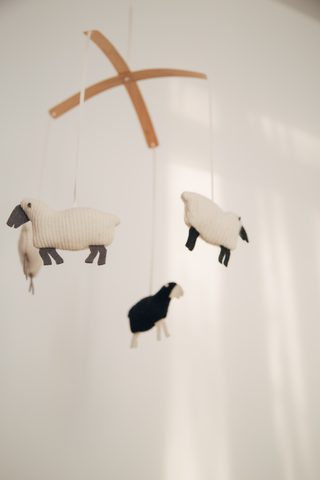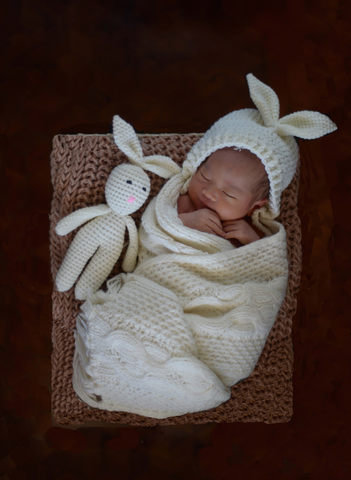The new and exciting path of parenthood can be one of the greatest experiences you'll have and equally one of the most challenging. New parents often find the sleep disruption to one of the most stressful parts of becoming a mum or dad.
Night feeds will persist for some time and a crying baby is one trying to communicate with its parents. Both scenarios can be as overwhelming as they are beautiful. Restful nights seem like a distant dream as your new nighttime now consists of a routine of feeding, waking suddenly to your baby's cries and the endless search for that lullaby - the one that sends your little one off to a deep and blissful sleep.
These challenges are completely normal, and at Baby Dink, we've all been there! Learning to understand your new baby's cues, settling your baby and establishing a consistent sleep routine is paramount to your mental health as a new parent.
You've likely heard many tales and methods from other parents about how to put babies to sleep. From swiftly and gently rocking, to co-sleeping and sleep association, below, we've shared some of the best ways to put your bundle of joy to sleep.
With these methods, we believe it's possible to learn how to put a baby to sleep in 40 seconds, which might feel a touch ambitious, but with time and patience, we think you can do it!

How do I know my baby is tired?
Though babies obviously can't communicate with words, they are definitely communicating their needs to you. Observing your baby's signals and cues is essential to avoiding the pitfalls of an over tired or distressed baby.
Here are the top cues to look out for a tired baby:
Eye rubbing and yawning
While these signs are easily noticeable, they often hint that your baby is already transitioning into a state of tiredness. Recognising these signs early can help initiate an early bedtime so your baby can fall asleep when they're already feeling lethargic.

Fussiness, reduced interest and crying
A baby's cry is a strong indication they could be tired and crying is lone of their more common baby-tired signs. Another is when your baby suddenly loses interest in their favourite toys or becomes unusually fussy, it's often a way of communicating they're feeling sleepy.
Physical cues
Some other, more covert signals, can include subtle movements like pulling at ears, clenching fists or small jolts can mean your baby needs some rest. For parents who co-sleep or are considering it, understanding these cues can be vital to ensuring your baby gets sufficient sleep. Recognising and responding to these signs early not only fosters a deeper bond between parent and child but also ensures a more harmonious sleep for the family members who are co-sleeping.
Our best settling techniques for babies
Understanding the intricacies of putting baby to sleep or getting them to settle if they're tired, hungry or irritable is similar to crafting a secret language - it needs to be refined over time and tailored for each baby - every baby is unique. Any seasoned child health nurse would agree that most babies exhibit an array of signals, some subtle and some overt, that they use to communicate their comfort, tiredness or hunger.
It's crucial to understand how babies are transitioning from the comfort of their mother's womb. For them, the world is a vast expanse of new and sometimes overwhelming sounds, noises and smells, so learning how to help and settle your baby is essential.
Here are some of our favourite settling techniques:
Hands on settling
To help baby sleep, hands on settling which can involve a range of actions is one of the most soothing way to help a new baby to go to sleep. A newborn baby's memory of the womb environment is profound in the first few months and mimicking this environment can be a powerful tool to help them relax.
Gently rock or gently stroke your baby, taking care of baby's head, if they're feeling unsettled. Gentle rhythmic patting, especially on their back or bottom, can also recreate the soothing rhythm of a mother's heartbeat they once felt in the womb to help them drift to sleep or simply to settle your baby. Skin to skin contact is also one of the best ways to help your baby sleep.
White noise
To a baby fresh from the protective cocoon of the womb, our world can be unnervingly loud, with different noises they might not have heard before. White noise machines or apps can bridge this gap, offering a gentle, consistent backdrop of sound your baby can associate with safety.
Sleep routine
Creating a sense of predictability with a consistent sleep schedule goes a long way in helping a baby relax and prepare for bedtime. It also helps them with having consistent sleep cycles. A sleep routine that is performed at the same time every night, which might include things your child associates with sleep like a warm bath, rhythmic night feeds, or a softly read story, acts as a series of cues to signal the time for sleep is approaching. By consistently punctuating their day with these familiar steps, your baby will come to associate those signals with nap or bed time!
Swaddling
Swaddling, similar to gentle rhythmic patting, provides a comforting embrace mimicking the womb's environment, where they are wrapped up with a comforting blanket, helping younger babies feel safe and secure. When wrapped correctly, swaddling allows your baby to relax and often leads to a deeper sleep. However, while swaddling can help your baby settle, it's vital to ensure they have enough room to move their little hips and legs.
Have a look at our range of baby swaddles

Responsive settling
By tuning into your baby's tired signs, you can anticipate your baby's needs and help prevent them from becoming over tired. Responsive settling isn't just about recognising tired signs. It's also about ensuring your baby's environment is conducive to them relaxing and being responsive to their needs when baby falls asleep and is baby wakes.
Feeding
Night feeds are essential for very young babies. Their teeny tiny stomachs mean they can only have a small amount of food at a time, which means they often get hungry, making it one of the main reasons they wake up. By attending to your baby's hunger promptly, through breastfeeding or bottle-feeding, you can help your baby get back to sleep quicker.
Comfort settling techniques
Understanding how to settle your baby is both rewarding and challenging. Babies cycle through significant change as they develop, so it's imperative to adapt your approaches and remain aware of your baby's behaviour as they get older.
Here are some tried and tested comfort settling tips:
Sleep association
Sleep association is when a child associates a certain sound, thing or action that is associated with sleep and bedtime and, they're one of the most effective ways to help a baby relax and prepare to fall asleep. By introducing a consistent sleep scheduling involving a particular blanket, soft toy, mobile, white noise machine or even a gentle lullaby, parents can signal to their baby that it's time for rest. The more frequently these things are used, the more ingrained they become and most newborns begin to associate that these things with the comfort of sleep, making the process of putting your baby down smoother.

Dummies
Dummies can be a comforting way tool for many newborn babies. The innate urge to suck provides comfort and familiarity for babies, helping them to fall asleep. Dummies are safe to use at night time and although your little one might drop it in the night, they'll let you know if they want its comfort again.
Room environment
The decor and feel of your baby's room or nursery can play a large role in how easily your baby sleeps. A gentle rhythmic patting combined with the room's soft, warm lighting can be incredibly soothing, again, mimicking the comfort of the womb.
A room with a comfortable temperature is also important and white noise machines or apps can further create a conducive sleep environment. If you're up for making the room extra cosy, you could even add a hint of lavender to help your baby drift into sleep.

How to settle your little one at any age
Learning how to put your baby to rest is a task requiring patience, understanding and a touch of resilience! It's important to remember that as babies grow and evolve, so do their sleep needs and patterns.
Here are some of our favourite ways to settle a child of any age:
Consistency
Consistency in a baby's sleep routine is essential in having peaceful and easy sleep for both you and your child. Child health experts often advocate for maintaining a routine to help your baby anticipate bedtime. As well as a regular timed schedule, a consistent sleep routine could also include consistent sleep associations as mentioned above.
Night feeds
The frequency of night feeds can begin to decrease, as little ones approach the six-month mark, leading to longer sleep durations. There is no one size fits all approach for this so ensure your baby's nutritional needs are met and the process of reducing feeding is gradual to prevent your baby from becoming over tired or hungry.
Engage and educate
As babies transition into toddlerhood, getting them involved in their bedtime routine, in sleep associations or lullabies might make the process smoother. By making bedtime a team effort, not only do you help your baby understand and anticipate the bedtime schedule, but you also transform it into a treasured nightly ritual both parents and children can look forward to.

Wrapping up
The journey to understanding your baby's needs, behaviours and sleepy signals can be challenging at times. If you're experimenting with various methods, we know you'll find a path to peaceful nights and energised mornings with understanding and patience, so both you and your baby can get some rest. Listening to babies cry and babies waking through the night can be extremely difficult at sleep time and if you're struggling, consider reaching out to a child health nurse who are experts at helping babies fall asleep.








Leave a comment (all fields required)